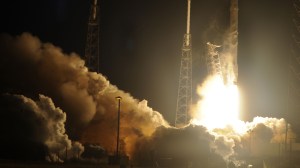In spite of a successful rocket launch on Saturday, things didn’t quite work out as SpaceX had hoped, when it tried to make history with an experiment.

The Falcon 9 rocket lifted off as scheduled at 4:47 a.m. ET from Cape Canaveral, Florida, on a routine mission to resupply the International Space Station.
What went up is doing fine. What came down didn’t quite, but the the rocket scientists were almost counting on that, and they’re not too disappointed.
The company tried to land the first section of the rocket, which is 14 stories tall, back down gingerly and on its feet on Earth, while the rest of the rocket continued on.
A floating landing pad was waiting out in the Atlantic ocean for the booster. It made it there, but came down a little too hard, SpaceX founder Elon Musk said in a tweet.
“Rocket made it to drone spaceport ship, but landed hard. Close, but no cigar this time.”
Don’t lose it; reuse it
Normally, once it has vaulted the rest of the rocket to space, the huge booster falls back into the ocean as, basically, garbage. That has been compared to throwing away a Boeing 747 passenger jet after it makes one transatlantic flight.
But SpaceX has been determined to change the practice to save millions in costs. Instead of losing the biggest part of the rocket, the company aims to reuse it.
The Falcon 9 is made up of two sections, called stages, that contain engines. On top of the rocket is the capsule, which carries its payload. It could also carry astronauts some day.
After the launch — then the separation from the second stage of the rocket — the Falcon 9 rocket’s booster turned around to head back down to the floating platform.
The company logo’s signature “X” marked the spot in the middle of a bull’s eye on the black tarmac of the “spaceport drone ship” that plowed through the water autonomously — with no need of human drivers, who could get hurt in a bang-up.
Some stuff on the ship did get dinged when the rocket plunked down on it, Musk said in a tweet.
Second try
The originally planned launch on Tuesday was scrubbed due to technical issues that turned up in the rocket’s second stage.
Scratching a launch time is routine for the space industry — sometimes due to weather, sometimes for technical reasons.
As Musk said when a different model rocket self-detonated as a safety measure during a soft-landing test in August: “Rockets are tricky.”
The official mission
Though the landing was a test, the launch was not. The “Dragon” capsule is carrying a payload of up to about 5,000 pounds to the ISS.
With five previous trips, the resupply missions have become somewhat routine. And this one appeared to be going as planned on Saturday.
The Dragon will land back on Earth the usual way in four and a half weeks, plopping into ocean water, after blazing back through the atmosphere with red-hot heat shields glowing at up to 3,000 degrees Fahrenheit.
The historic part
SpaceX has tried the landing experiment before, with the exception of the last step. If the Falcon 9’s booster had pulled off the landing on the platform, that would have been historic.
In previous experiments, engineers brought it down softly into the water.
Here’s how the booster was designed to get back down to Earth.
First, fall at a speed of about a mile a minute. Then fire boosters three times in sequence, which Space X describes in colorful terms.
The first boost, called the “boostback burn” turns the bottom of the first stage downward, then the “supersonic retro propulsion burn” cuts the fall speed to about 800 feet per second. Then comes the “landing burn,” when the landing gear legs also push out for the set-down.
By then the booster descends at a speed of about seven feet per second.
Falcon 9 boosters have gone through these phases successfully in two prior tests, SpaceX said. At the end, the rockets tipped sideways and crashed into the ocean, causing damage that made them unusable.
But that was according to plan, SpaceX said.
Setting down with its landing legs onto the platform would have made history, preserving the booster for its possible reuse.
Though it didn’t work out, SpaceX didn’t necessarily expect it to. It had puts the odds of success of this first try at 50% — at best.















